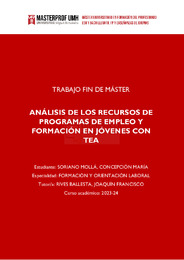Please use this identifier to cite or link to this item:
https://hdl.handle.net/11000/32883Full metadata record
| DC Field | Value | Language |
|---|---|---|
| dc.contributor.advisor | Rives Ballesta, Joaquín Francisco | - |
| dc.contributor.author | Soriano Mollá, Concepción María | - |
| dc.contributor.other | Departamentos de la UMH::Estadística, Matemáticas e Informática | es_ES |
| dc.date.accessioned | 2024-08-02T10:50:56Z | - |
| dc.date.available | 2024-08-02T10:50:56Z | - |
| dc.date.created | 2024-06 | - |
| dc.identifier.uri | https://hdl.handle.net/11000/32883 | - |
| dc.description | Especialidad: Formación y orientación laboral | es_ES |
| dc.description.abstract | Este Trabajo de Fin de Máster intenta mostrar diferentes maneras de formación y empleo, es decir, un enfoque formativo mixto que pueda permitir a jóvenes con Autismo adquirir una formación que, combinada con prácticas laborales les ayude a conseguir su inserción laboral y de esta manera adquirir su propia autonomía, aumentar su autoestima y su independencia económica. En definitiva, conseguir una calidad de vida a través de la formación y el empleo. No sólo es inquietante, sino también lamentable, que a pesar de las numerosas ventajas que se ofrecen para contratar a personas con discapacidad intelectual, su situación laboral sea precaria. El objetivo de este trabajo es dar más visibilidad a los jóvenes diagnosticados con trastorno del espectro autista, que se caracterizan por tener comportamientos repetitivos, patrones de actividad atípicos, falta de habilidades comunicativas y dificultad en la interacción social. Cada año hay más alumnado diagnosticado en las aulas de centros educativos. La finalidad de este trabajo es conocer cómo mejorar su aprendizaje y adaptación al mundo laboral. Sin embargo, es importante resaltar que con la madurez muchos de sus síntomas mejoran. Es decir, socializan más con otras personas, tienen menos problemas en su comportamiento o lenguaje, lo que facilita su independencia y calidad de vida. | es_ES |
| dc.description.abstract | This Master's Thesis attempts to show different ways of training and employment, that is, a mixed training approach that can allow young people with Autism to acquire training that, combined with employment practices, will help them to achieve their job placement and thus be able to acquire their own autonomy, increase their self-esteem and their economic independence. In short, to achieve a quality of life through training and employment. It is not only disturbing, but also regrettable that despite the numerous advantages offered for hiring people with intellectual disabilities, their employment situation is precarious. The objective of this work is to give more visibility to young people diagnosed with autism spectrum disorder, who are characterized by having repetitive behaviors, atypical activity patterns, lack of communication skills and difficulty in social interaction. There are more and more students diagnosed in the classrooms of educational centers each year. The purpose of this work is to find out how to improve their learning and adaptation to the world of work. However, it is important to highlight that with maturity, many of their symptoms improve. In other words, they socialize more with other people, they have fewer problems in their behavior or language, which facilitates their independence and quality of life. | es_ES |
| dc.format | application/pdf | es_ES |
| dc.format.extent | 30 | es_ES |
| dc.language.iso | spa | es_ES |
| dc.publisher | Universidad Miguel Hernández de Elche | es_ES |
| dc.rights | info:eu-repo/semantics/openAccess | es_ES |
| dc.rights.uri | http://creativecommons.org/licenses/by-nc-nd/4.0/ | * |
| dc.subject | Diversidad funcional | es_ES |
| dc.subject | Discapacidad intelectual | es_ES |
| dc.subject | Inserción | es_ES |
| dc.subject | Inclusión | es_ES |
| dc.subject | Discriminación | es_ES |
| dc.title | Análisis de los recursos de programas de empleo y formación en jóvenes con TEA | es_ES |
| dc.type | info:eu-repo/semantics/masterThesis | es_ES |

View/Open:
SORIANO MOLLA, CONCEPCION MARIA.pdf
1,06 MB
Adobe PDF
Share:
.png)
